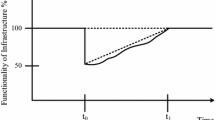Abstract
In this paper we present an integrated approach to the evacuation problem under an emergency situation for transportation systems. The approach is based on a view that a service system has two subsystems: infrastructure and substance. The approach attempts to integrate infrastructure design and substance flow planning to improve the evacuation performance. Without loss of generality, we restrict infrastructure design to reconstruction of a damaged road with two attributes of the road: capacity and travel time, we restrict substance flow planning to the contraflow method, and we consider the evacuation problem with single source and single destination. Further, we apply the discrete variable Particle Swarm Optimization and RelaxIV to solve the problem model. The overall objective function in the problem model is a minimum transportation time. Since recovery of a damaged transportation (damaged road in this case) is implied in our problem, the proposed approach has some significant implication to resilience engineering of a service system as well. An example is studied to show the effectiveness of our approach; in particular it is shown that an integrated solution is significantly better than the solution with only the contraflow method.








Similar content being viewed by others
References
Bertsekas DP, Tseng P (1994) Relax IV: a fast version of the Relax code for solving minimum cost flow problems. In: LIDS-P-2276, MIT, Cambridge
Du Y, Qi L, Zhou M (2011) A vector matching method for analysing logic Petri nets. Enterp Inf Syst 5(4):449–468
Eberhart RC, Kennedy J (1995) A new optimizer using particle swarm theory. In: Proceedings on international symposium on micro machine and human science, Nagoya, Japan, pp 39–43
Erol O, Sauser B, Mansouri M (2010) A framework for investigation into extended enterprise resilience. Enterp Inf Syst 4(2):111–136
Gwynne SS, Galea ER, Owen M, Lawrence PJ, Filippidis L (1999a) A review of the methodologies used in evacuation modeling. Fire Mater 23:383–388
Gwynne S, Galea ER, Owen M, Lawrence PJ, Filippidis L (1999b) A review of the methodologies used in the computer simulation of evacuation from the built environment. Build Environ 34(6):741–749
Hamacher HW, Tjandra SA (2002) Mathematical modelling of evacuation problems: a state of art. In: Schreckcnberg M, Sharma SD (eds) Pedestriori and evacuation dynamics. Springer, New York, pp 227–266
He Y (2008) A novel approach to emergency management of wireless telecommunication system. Master thesis, Department of Mechanical Engineering, University of Saskatchewan, Saskatoon
Hollnagel E, Paries J, Woods D, Wreathall J (2010) Resilience engineering in practice: a guide book. Ashgate, Aldershot
Kanno T, Fujii T, Watarir R, Furuta K (2011) Modeling and simulation of a service system in a disaster to assess its resilience. In: 4th Resilience engineering international symposium, Sophia-Antipolis
Kennedy J (1997) The particle swarm: social adaptation of knowledge. In: Proceedings of the IEEE international conference on evolutionary computation, Indianapolis, IN, USA, pp 303–308
Kennedy J, Eberhart RC (1995) Particle swarm optimization. In: Proceedings of IEEE international conference on neural networks, Perth, Australia, vol 4, pp 1942–1948
Kennedy J, Eberhart RC (1997) A discrete binary of the particle swarm algorithm. In: Proceedingds of the IEEE international conference on systems, man and cybernetics, Orlando, Fl, USA, pp 4104–4108
Kim S, Shekhar S, Min M (2008) Contraflow transportation network reconfiguration for evacuation route planning. IEEE Trans Knowl Data Eng 20(8):1115–1129
Kuligowski ED, Peacock RD (2005) A review of building evacuation models. National Institute of Standards and Technology, Technical Note 1471
LaPorte TR (1996) High reliability organizations: unlikely, demanding, and at risk. J Contingen Crisis Manag 63(4):60–71
Leveson N, Dulac N, Zipkin D, Cutcher-Gershenfeld J, Carroll J, Barrett B (2006) Engineering resilience into safety-critical systems. In: Hollanagel E, Woods DD, Leveson N (eds) Resilience Engineering: concepts and precepts. Ashgate Publishing Limited, Burlington, pp 95–124
Lhonmme S, Toubin M, Serre D, Diab Y, Laganier R (2011) From technical resilience toward urban services resilience. In: 4th Resilience engineering international symposium, Sophia-Antipolis
Li Q, Zhang WJ, Chen L (2001) Design for control (DFC): a concurrent engineering approach for mechatronic system design. IEEE/ASME Trans Mechatron 6(2):161–169
Liu X, Tu Y, Zhang WJ, Deters R, Chai C (2006) A generic architecture of the networked critical infrastructure system: GANetCI. In: Third conference on critical infrastructure, Old Town Alexandria
Liu D, Deters R, Zhang WJ (2010) Architectural design for resilience. Enterp Inf Syst 4(2):137–152
Mamada S, Makino K, Takabatake T, Fujishige S (2003) The evacuation problem dynamic network flows and algorithms. In: Proceedings of SICE annual conference, Fukui, Japan, vol 3, pp 2807–2811
Mamada S, Makino K, Fujishige S (2004) Evacuation problems and dynamic network flows. In: Proceedings of SICE annual conference, Sapporo, Japan, vol 1, pp 530–535
Marais K, Dulac N, Leveson N (2004) Beyond normal accidents and high reliability organizations: the need for an alternative approach to safety in complex systems. In: Engineering systems division symposium, MIT, Cambridge
Perrow C (1999) Normal accidents: living with high-risk technologies. Princeton University Press, Princeton
Raj R, Wang JW, Nayak A, Tiwari MK, Han B, Liu CL, Zhang WJ (2015) Measuring resilience of supply chain systems using a survival model. IEEE Syst J 9(2):377–381
Roberts KH (1990) Managing high reliability organizations. Calif Manag Rev 32(4):101–114
Santos G, Aguirre BE (2004) A critical review of emergency evacuation simulation models. In: Proceedings of conference on building occupant movement during fire emergencies, Gaithersburg, Maryland
Simonovic SP, Ahmad S (2005) Computer-based Model for flood evacuation emergency planning. Nat Hazards 34(1):25–51
Sterman JD (2000) Business dynamics: systems thinking and modeling for a complex world. McGraw Hill, New York
Tu YL, Zhang WJ, Liu X, Li W, Chai C, Deter R (2008) A disaster response management system based on the control systems technology. Int J Crit Infrastruct 4(3):274–295
Urbina E, Wolshon B (2003) National review of hurricane evacuation plans and policies: a comparison and contrast of state practices. Transp Res Part A 37(3):257–275
Wadoo SA, Kachroo P (2006) Feedback control design and stability analysis of two dimensional evacuation system. In: Proceedings of the IEEE ITSC, Toronto, Canada, pp 1108–1113
Wadoo SA, Kachroo P (2010) Feedback control of crowd evacuation in one dimension. IEEE Trans Intell Transp Syst 11(1):182–193
Wang JW (2013) Towards a resilient networked service system. Ph.D. thesis, Department of Mechanical Engineering, University of Saskatchewan, Saskatoon
Wang JW, Wang DW (2008) Particle swarm optimization with a leader and followers. Prog Nat Sci 18(11):1437–1443
Wang JW, Gao F, Ip WH (2010a) Measurement of resilience and its application to enterprise information systems. Enterp Inf Syst 4(2):215–223
Wang JW, Ip WH, Zhang WJ (2010b) An integrated road construction and resource planning approach to the evacuation of victims from single source to multiple destinations. IEEE Trans Intell Transp Syst 11(2):277–289
Wang JW, Ip WH, Muddada RR, Huang JL, Zhang WJ (2013a) On Petri net implementation of proactive resilient holistic supply chain networks. Int J Adv Manuf Technol 69(1–4):427–437
Wang JW, Wang HF, Ip WH, Furuta K, Kanno T, Zhang WJ (2013b) Predatory search strategy based on swarm intelligence for continuous optimization problems. Math Prob Eng. doi:10.1155/2013/749256
Wang JW, Wang HF, Zhang WJ, Ip WH, Furuta K (2013c) Evacuation planning based on the contraflow technique with consideration of evacuation priorities and traffic setup time. IEEE Trans Intell Transp Syst 14(1):480–485
Wang JW, Wang HF, Zhang WJ, Ip WH, Furuta K (2014) On a unified definition of the service system: what is its identity? IEEE Syst J 8(3):821–826
Wang JW, Song MY, Zhou YM, Ding JL (2015) Origin and development of resilience engineering: a perspective on safety engineering. Control Eng China 22(4):1–10
Wang JW, Muddada RR, Wang HF, Ding JL, Lin Y, Zhang WJ (2016a) Towards a resilient holistic supply chain network system: concept, review and future direction. IEEE Syst J 10(2):410–421
Wang JW, Wang HF, Ding JL, Furuta K, Kanno T, Ip WH, Zhang WJ (2016b) On domain modelling of the service system with its application to enterprise information systems. Enterp Inf Syst 10(1):1–16
Wolshon B, Urbina E, Levitan M, Wilmot C (2005a) Review of policies and practices for hurricane evacuation. II: traffic operations, management, and control. Nat Hazards Rev 6(3):143–161
Wolshon B, Urbina E, Wilmot C, Levitan M (2005b) Review of policies and practices for hurricane evacuation. I: transportation planning, preparedness, and response. Nat Hazards Rev 6(3):129–142
Xue D, Dong Z (2000) An intelligent contraflow control method for real-time optimal traffic scheduling using artificial neural network, fuzzy pattern recognition, and optimization. IEEE Trans Control Syst Technol 8(1):183–191
Yu Y, Tang J, Li J, Sun W, Wang JW (2016) Reducing carbon emission of pickup and delivery using integrated scheduling. Transp Res Part D Transp Environ 47:237–250
Zhang WJ, Lin Y (2010) On the principle of design of resilient systems-application to enterprise information systems. Enterp Inf Syst 4(2):99–110
Zhang WJ, van Luttervelt CA (2011) Toward a resilient manufacturing system. CIPP Annu Manuf Technol 60:469–472
Zhang WJ, Li Q, Guo LS (1999) Integrated design of mechanical structure and control algorithm for a programmable four-bar linkage. IEEE/ASME Trans Mechatron 4(4):354–362
Acknowledgements
We thank the financial support to this work by the National Natural Science Foundation of China (NSFC) (Grant No. 71571156), by a grant from the Research Grants Council of the Hong Kong Special Administrative Region, China (Project No. [T32-101/15-R]), by the University of Hong Kong through the Seed Funding Programme for basic research (Grant Nos. 201409159015, 201511159252), and by the open project funded by State Key Laboratory of Synthetical Automation for Process Industries (PAL-N201505) to J. W. Wang and National Science and Engineering Research Council of Canada through a Strategic Project Grant to W. J. Zhang.
Author information
Authors and Affiliations
Corresponding author
Rights and permissions
About this article
Cite this article
Wang, J.W., Wang, H.F., Zhou, Y.M. et al. On an integrated approach to resilient transportation systems in emergency situations. Nat Comput 18, 815–823 (2019). https://doi.org/10.1007/s11047-016-9605-y
Published:
Issue Date:
DOI: https://doi.org/10.1007/s11047-016-9605-y




